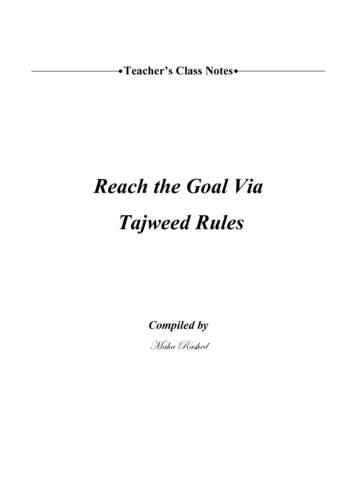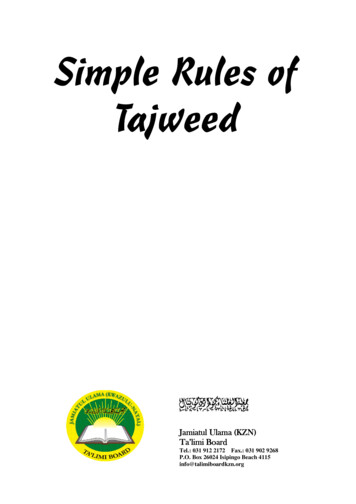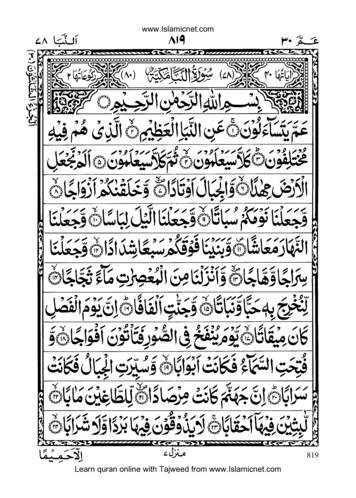
Transcription
Teacher’s Class NotesReach the Goal ViaTajweed RulesCompiled by t{t etá{xw
Table of ContentsIntroduction. 1Tajweed . 5Benefits of learning Tajweed . 5Rules of Noon and Meem Mushaddad . 6Alqalqala . 7The heavy and light letters. 8Laam in the exalted name of Allah . 10Ruling of RAA letter being heavy or light. 12Rules of Noon Saakinah and Tanween . 13Izhaar Halqy . 14Iqlaab . 15Idghaam . 16Ikhfaa Haqiqi . 18Chart for Rules of Noon saakin and Tanween . 20How to pronounce each rules . 21Rules of Meem Saakin . 24Ikhfaa Shafawi . 24Idghaam Mutamathelayn Sagheer . 25Izhaar Shafawi . 25Chart for Rules of Meem Saakin. 26Al-Madd . 27
Maddd Tabee'. 28Madd Badal . 29Madd Ewad . 29Maddd Aridh Lissukoon. 30Maddd Leen . 30Madd Wajib Mutassil . 31Madd Jae'z Munfasil . 31Madd Laazim . 32Madd Laazim Kalemee Muthaqqal. 32Madd Laazim Kalemee Mukhaffaf . 33Madd Laazim Harfee Muthaqqal. 33Madd Laazim Harfee Mukhaffaf. 34Chart for Madd . 35Stopping at the end of words . 36The Qualities of the letters. 37Permenant Qulities with opposites . 38Al-Jahr and Al-Hams . 38Asheddah, Attawasut and Arrakhawa . 39Istifaal and Iste'elaa. 40Al-infetaah and Al-Itbaaq . 40Al-Izlaaq and Al-Ismaat. 40Permenant Qulities without opposites . 41Alqaqala . 41
As-Safeer . 42Al-Leen . 42Al-Inhiraf. 42At-Takreer . 43At-Tafasshy . 43Istitaalah . 43Referances. 44
1st editionReach the goal via Tajweed ruleIntroductionWhat is Tajweed?The word Tajweed linguistically means ‘proficiency’ or ‘doing something well’.When applied to the Qur’an, it means giving every letter of the Qur’an its rights and dues ofcharacteristics when we recite the Qur’an and observing the rules that apply to those letters indifferent situations. We give the letters their rights by observing the essential characteristicsof each letter that never leave it. And we give them their dues by observing thecharacteristics of each letter that are present in them some of the time and not present at othertimes.The Qur’an was revealed with Tajweed rules applied to it. In other words, when theangel Jibreel ((AS)) recited the words of Allah to the Prophet Muhammad (SAW) he recitedthem in a certain way and he showed the Prophet (SAW) the ways in which it waspermissible to recite the Qur’an. So it is upon us to observe those rules so that we recite it inthe way it was revealed.History of TajweedAt the time of the Prophet (SAW) there was no need for people to study Tajweedbecause they talked with what is now known as Tajweed so it was natural for them. When theArabs started mixing with the non-Arabs as Islam spread, mistakes in Qur’an recitationstarted appearing, so the scholars had to record the rules. Now, because the everyday Arabicthat Arabs speak has changed so much from the Classical Arabic with which the Qur’an wasrevealed, even Arabs have to study Tajweed.The purpose of TajweedThe Qur’an is the word of Allah, and its every syllable is from Allah. Its recitationmust be taken very seriously. The purpose of the Science of Tajweed in essence is to makethe reciter proficient in reciting the Qur’an, observing the correct pronunciation of everyletter with the rulings and characteristics which apply to each letter, without any exaggerationor deficiency. And so through this the reciter can recite the Qur’an upon the way of theProphet pbuh. as he received it from Jibreel who received it from Allah (SWT) in theClassical Arabic dialect that it came down in.Arabic letters each have a Makhraj – an exit or articulation point - in the mouth orthroat from which they originate and they also each have Sifaat – attributes, or characteristics- particular to them. Knowing the Makhraj and Sifaat of each letter is an important part ofTajweed. Sometimes two letters have very similar exits which makes mixing them up easy.So if a person does not know the attributes of each letter there is a danger that he will changethe meaning of the words in Qur’an recitation. Observing the rules of Tajweed in recitingprotects the reciter from making mistakes in reciting the Qur’an.The ruling of reading with TajweedMuhammad bin Al-Jazaree the great Qur’an and Hadeeth scholar of the 9th Century(Hijri) says in his famous poem, detailing the rules of Tajweed: “And applying Tajweed is an1
Reach the goal via Tajweed rule1st editionissue of absolute necessity, whoever doesn’t apply Tajweed to the Qur’an, then a sinner ishe.”So he regarded it as an obligation and he regarded leaving it as a sin. And themajority of scholars agree that applying the Tajweed rules of Qur’an are an individualobligation ( ) upon every Muslim who has memorized or read part of or all of theQur’an. That is because the Qur’an was revealed with the Tajweed rules applied to it and theProphet (SAW) recited it back to Jibreel in that way and the Companions of the Prophet(SAW) read it in that way, so it is an established Sunnah.The obligation of TajweedThe proofs that the scholars bring to show the obligation of Tajweed is that Allahsays in the Qur’an, ξ‹Ï?ö s? tβ#u ö à)ø9 # È Ïo?u‘uρ ϵø‹n t㠊Η ρr&The meaning of which is: ‘And recite the Qur’an (aloud) in a (slow and melodious) style(tarteela)’ (Surah Muzzammil, Ayah 4)Ali ibn Abi Talib (RA) said in the explanation of this aayah: “at-Tarteel is Tajweed ofthe letters and knowing where to stop (correctly)”.[An-Nashr of Ibn Al-Jazaree 209:1]And of the rights of reciting correctly is reciting it the way it was revealed. There arevarious Ahadeeth also showing us the importance of Tajweed. Umm Salamah was askedabout the recitation of the Prophet (SAW) and she described it as a recitation ‘clearlydistinguished letter by letter’.[Tirmidhi]Sa’eed bin Mansoor relates in his Sunan that a man was reciting the Qur’an toAbdullah bin Mas’ood and he recited “Innamas sadaqaatu lil fuqara-i wal masaakeen”, so Ibnmas’ood said: “This was not how the Messenger of Allah (SAW) recited it to me!” So theman asked, “How did he read it to you oh Aba Abdir-Rahman?” So he said “Lil Fuqaraaaa-iwal masaakeen”, he elongated the word Fuqaraa and the knowledge of the different lengthsof elongation (mudood) is also from the rules of Tajweed.Ibn al-Jazari (may Allaah have mercy on him) said: Whoever is able to read thewords of Allah with correct Arabic pronunciation but he deliberately pronounces itincorrectly like a non-Arab, out of arrogance, stubbornness and complacency, or because heis too proud to go to a scholar who could help him to correct his pronunciation, isundoubtedly falling short and sinning and being dishonest. The Messenger of Allaah (pbuh)said: “Religion is sincerity: to Allah, to His Book, to His Messenger, and to the leaders of theMuslims and their common folk.”It is not permissible for anyone to deliberately change any letter of it when he is ableto pronounce it correctly. This is a kind of mistake which is a sin. If a person finds it difficult2
Reach the goal via Tajweed rule1st editionto pronounce the letters correctly – such as people in whose language some of the Arabicletters, such as ظ , ذ and خ do not exist – they have to try to learn the correct pronunciation,but if they are unable to master it then they are excused, but their example should not befollowed, and they should be called upon to strive their hardest to learn and correct theirpronunciation. And none of them should lead the prayer, unless he is leading others like himwho cannot pronounce well either. (1)Mistakes in Tajweed:The scholars have divided the types of mistakes one might fall into when reciting the Qur’aninto two types:1.Clear mistakes and2.Unobvious (hidden) mistakes.The Clear mistakes must be avoided by all and to avoid them one must know the rulesof Tajweed. If a person falls into the Clear Mistakes, this is considered a sin and IbnTaymiyyah even regarded it undesirable for a Student of Knowledge (i.e. someone whoknows Tajweed) to pray behind a person who makes Clear Mistakes in their Salaah. As forthe Unobvious mistakes, then the ruling on them is lighter and the recitation of a personfalling into this type of mistake is regarded as lacking in completeness and prayer behindsuch a person is sound.Reciting the Qur’an melodiouslyThe Prophet (SAW) used to recite the Qur’an in slow, measured, rhythmic tones asAllah had instructed him, not hurriedly, but rather “he would recite a surah in such slowrhythmic tones that it would be longer than it would seem possible.”[Muslim, Muwatta] Hewould stop at the end of each aayah [Abu Dawud]. He commanded people to recite in abeautiful voice in a pleasant melodious tone. He said “Beautify the Qur’an with your voices[for a fine voice increases the Qur’an in beauty]”[Bukhari] and he said “He who does notrecite the Qur’an in a pleasant tone is not of us.”[Abu Dawud]Unfortunately all too often we find people reciting the Qur’an quickly and withoutchanging their tone and without any feeling. We should put all our efforts into reciting theQur’an with as much feeling as we can! Have you ever prayed behind an Imam who readwith feeling? Well the Prophet (SAW) said “Truly the one who has one of the finest voicesamong the people for reciting the Qur’an is the one whom you think fears Allah when youhear him recite.”[Daarimi, Tabaraani]And once when the Prophet (SAW) complimented Abu Moosaa al-Ash’ari on thebeauty of his recitation, Abu Moosaa said “Had I known you were there, I would have ari,Muslim]Let us remember, that the Qur’an is the word of Allah. In it we find exhortations,warnings, glad-tidings, parables, stories of the past, commands and prohibitions. Aayaat tomake us think, reflect, cry, fear, hope, love, fall down in prostration! How can we recite all of167586 www.islam-qa.com3
Reach the goal via Tajweed rule1st editionthis without feeling!? When we recite an aayah of Qur’an we should imagine that we aretrying to feel and convey the full message behind that aayah. Perhaps some of us don’t feelconfident.I believe that this lack of confidence comes partly from not knowing the rules ofTajweed correctly and so fearing that we will make mistakes and partly from notunderstanding the meaning of what we are reciting. So let us work hard to remove these twoobstacles by learning Tajweed and working towards learning Arabic.Helpful Tips towards learning Tajweed* You must find a Qur’an teacher who has studied Tajweed to listen to your recitation andcorrect you. Tajweed cannot merely be learnt from books, because the movements of yourmouth as well as the sounds are important and only a teacher can correct you and make sureyou are applying the rules correctly. Qur’an recitation is a science which was passed downgeneration by generation through teachers not just books, with a direct line to the Prophetpbuh.* Follow this book containing the rules of Tajweed and learn each rule little by little,applying it as you go along with the help of your teacher. Following the charts will make llah.* Listen to Qur’an tapes of reciters who recite very clearly (you can find that also atwww.reciter.org), at a medium or slow speed and notice them applying the different rules ofTajweed. Repeat after them while trying to apply the rules you’ve learnt. Try to copy theirtone and melody as well and see how it changes as the meaning of what they’re recitingchanges.* Apply the rules you learn to the Surahs you have already memorized and don’t save anyeffort about reciting correctly. You might have to revise the surahs by looking back at them.* Practice and repetition will make perfect InshaaAllah: As Ibn al-Jazaree says in his poemabout acquiring Tajweed: ‘And there is no obstacle between it (learning Tajweed) andleaving it, Except that a person must exercise his mouth with it!’May Allah help us all to give His Book its right when we recite it and make reciting it morebeloved to our tongues than anything else. Aameen. t{t A etá{xw4
1st editionReach the goal via Tajweed ruleTajweedThe linguistic meaning of Tajweed is (to beautifysomething).The technical meaning of Tajweed is (to give every letter its right with its description and its origination)Benefits of learning TajweedThe benefits of learning Tajweed are many as reflected in some of thefollowing Ahadeeth: The reciters of the Qur’an will be in the company of the noble andobedient angels‘Aa’ishah, may Allah be pleased with her, relates that the Prophet(SAW) said: “Verily the one who recites the Qur’an beautifully,smoothly, and precisely, he will be in the company of the noble andobedient angels. And as for the one who recites with difficulty,stammering or stumbling through its verses, then he will have TWICEthat reward.” [Al-Bukhari and Muslim] You will be from the best of people‘Uthmaan, may Allah be pleased with him, said that the Prophet(SAW) said: “The best of you are the ones who learn the Qur’an andteach it to others” [Al-Bukhari] There are ten rewards for each letter you recite from the Quran“Whoever reads a letter from the Book of Allah, he will have areward. And that reward will be multiplied by ten. I am not sayingthat “Alif, Laam, Meem” is a letter, rather I am saying that “Alif” is aletter, “laam” is a letter and “meem” is a letter.” [Tirmidhi states thisis saheeh] The Qur’an will lead you to Paradise!The Qur’an is an intercessor, something given permission tointercede, and it is rightfully believed in. Whoever puts it in front ofhim, it will lead him to Paradise; whoever puts it behind him, it willsteer him to the Hellfire.” [An authentic hadith found in AtTabaraanee, on the authority of ‘Abdullaah ibn Mas’ood]5
1st editionReach the goal via Tajweed ruleRules of Noon and Meem Mushaddad The way of pronouncing:If a Meem or Noon is Mushaddad (that is, it has a shaddah sign on it), thereader must do Ghunnah (or Nasal sound) of 2 (beats) on it.Note: if the reader stops on a word ending with Noon or MeemMushaddad, the Gunnah for the Meem or Noon Mushadad still have tobe applied. Examples:-zΟ Ψyγpg¿2ÏπuŠÏ¹ Ζ9 Î/Ä Ψ9 # χãρu tIs9 βr&! ΡÎ) çµ Βé'sù Βr'sù! Βr&uρ§Νtã6
1st editionReach the goal via Tajweed ruleAl –Qalqalah The meaning of Qalqalah:Means vibration, it is the vibration of sound at the end of thepronunciation of a letter.It can be stated as a state between a Saakin (letter with Sukoon sign on it)and Mutaharrik (letter with Movement)Note: Qalqalah is only pronounced when the letter is Saakin (either theletter has the Sukoon sign or is assigned a sukoon because of stopping). Letters of Qalqalah:They are collected in the words [!" # ] OR [% & ' ( )] Examples:Ædkysø9 #uρî‰ymr&x8u‘ô‰ ¹‘,ptø: #߉yϑ Á9 #ΟßγyϑyèôÛr&¡ s?uρy‰ ¡ymç tIö/F{ #StrongestStrongWeak7
Letter ( ) فا ا The Heavy and light Letters وف ا وا If thefollowingletter is heavyGhunnahshould belightIf thefollowingletter is light The Ghunnahfor IkhfaaHaqiqiTemporary heavyand lightTypes of Arabic lettersconsidering their heavinessand lightnessThe AlifMadd ( )If theprecedingletter is light If theprecedingletter is heavyAlif Madd shouldbe pronouncedlightSee chart page (12)Reach the goal with Tajweed ruleHeavy lettersThe followingletters Alif Madd shouldbe pronouncedheavyGhunnahshould beheavyThe Restof thelettersLight letters1st editionLaam ( ) inthe Exaltedname of Allah – See chart page(10)8
1st editionReach the goal via Tajweed rule1. Heavy letters ا وف ا :They are collected in the phrase[ ] OR [ خ ص ض غ ط ق ]ظ The way of pronouncing a Heavy Letter:The heavy letters have the quality of Isti’laa 2 “rising high”.Because while pronouncing them, a part of the tongue (mostly the backpart) rises up to the roof makes the letter sound heavy.2. Light letters ا وف ا :-All the letters other than the heavy letters and the temporary heavyand light letters. The way of pronouncing Light Letters:The Light Letters have the quality of Istifaal 3 “falling down”, bylowering the tongue when pronouncing the light letter.3. Alif Madd أ ا The quality of Alif Madd being heavy or light depends on the letterpreceding Alif Madd. If the letter before Alif Madd was light, so Alif Maddshould accordingly take a light sound. And if the letter before Alif Maddwas heavy, so Alif Madd should accordingly take a heavy sound.4. The Ghunnah for Ikhfaa HaqiqiSee page 23 from Rules of Noon Saakinah and Tanween.23See page 40 for more details about Isti’laaSee page 40 for more details about Istifaal9
1st editionReach the goal via Tajweed rule5. Rules for The Laam of The Exalted Name of Allah ا م ا This is one of the temporary Qualitiesa) If there is a Fatha or a Dhamma before the word of Allah orAllahum, then laam in Allah will be heavy.Example: Οßγ 9 # (#θä9 s%§Νßγ 9 # š oΨ ysö6ß ª! # u ! t o„ª! #uρb) If there is a kasrah before the word Allah, then the Laam inAllah or Allahum will be lightExample: Οßγ 9 # È è%«! # Ç ƒÏŠ !«! Î/c) If the reader starts reading with the name of Allah, then Laamin Allah or Allahom will be heavy. 10
1st editionReach the goal via Tajweed ruleLaam ( ) in theExalted name of Allah If the letterbefore the nameof Allah has fathah orDhammahIf reader startsreading with thename of AllahLamm in Allahshould beheavyIf the letterbefore the nameof Allah hasKasrahLamm inAllahshould belight11
1st editionReach the goal via Tajweed rule4. Ruling of Raa’( )ر being HEAVY( ) or LIGHT( )Depends on theHarakah on Raa’ ( )ر ََOrôَُLightHeavyLook at theprevious letterُôَ ا or و HamzatulWasslHeavyLightHeavy5 ö ÏùÏŠ ¹ö Ïϑø9 Î7s9#YŠ ¹ö‘Î)uρ sÛö Ï% 7πs%ö ÏùHeavyBecause the following letter(in the same word) is heavyORLight(#þθç/ s?ö‘ # ÇΠr&î ö yz4 Ós?ö‘ # ”Ï% ! #Ö ƒÏ‰s%Except for#YŠ ¹ó É letter Yaa’( )ى yϑßγ Ηxqö‘ # Éb §‘û ÉëÅ ö‘ #LightHeavyَLook at the Harakah onthe previous letterHeavyُExceptional cases like:-Î ô o„ / Î ó r'sù / Í‘ä‹çΡρuَLightExcept foru óÇÏΒHeavyÌ ôÜÉ)ø9 #ORLight12
1st editionReach the goal via Tajweed ruleThe Rules of Noon Sakin and Tanween Noon Saakinah: is a Noon with no Harakah or with a Sukoon sign onit.Noon Saakinah. ن ô ن ن Tanween:- Is actually a noon Saakinah which comes at the end of thenouns. It is pronounced but not written as Noon Saakinah.Tanween7 R 7Yí ·Note: - Tanween only occurs at the end of nouns (except for two verbs)whereas Noon Saakinah may occur anywhere in a word (in the middle or atthe End).Rules of Noon Saakinah and Tanween4 4Izhar Halqi Idgham Iqlaab Ikhfaa’ Haqiqi Please refer to the chart page 20 to be able to find the rule and apply it while reciting Quran13
1st editionReach the goal via Tajweed ruleFirst: Izhaar Halqi Izhaar means “clear” Izhaar Letters: the throat letters The way of pronunciation :If a Noon Saakin or a Tanween is followed by any of the six throatletters, The Noon Saakin or the Tanween is pronounced clearly from itsrespective origination without Ghunnah. Examples on Noon Saakinô ن z Å yz ô yϑÏ9öΝåκ ]tãÈ δr& ô ÏΒÄd“r& ô ÏΒ Môϑyè Ρr&4‘sS Ζtƒ Examples on Tanweení ·}‘Ïδ íΟ n y #sŒÎ) # ‰ö7tã pκö n tæ ‹Í tΒöθtƒ7πy ÏÛ%s{ πt/É‹ x. ωÎ) îΠ yèsÛîπyèÏ yz ‹Í tΒöθtƒNote:- If the Tanween is followed by Hamzatul wassl( ) , the reader issupposed to pronounce the noon in the Tanween like Noon with Kasrah.Example: ” s)tGó¡çRùQ # ‹ tΒöθtƒ14
1st editionReach the goal via Tajweed ruleSecond: Iqlaab Iqlaab means: - “to turn over” Iqlaab letters:- “ ” The way of pronunciation:If a Noon Saakin or Tanween is followed by “ ”ب , it is converted into ahidden Meen with separating between lips. And the reader should makeGhunnah for 2 beats Examples on Noon Saakin uΖ Kt7/Ρr'sùω èt/ . ÏΒ Examples on TanweenzΟ Ψyγpg¿2 ‹Í tΒöθtƒÏπuŠÏ¹ Ζ9 Î/ Jèx ó¡oΨs915
1st editionReach the goal via Tajweed ruleThird: Idghaam Idghaam means: “To mix” or to “put one thing into another”. It is the mixing or enteringof a Saakin letter into a Mutaharrik letter following it, so that they became asingle Mushaddad letter. Idghaam Letters:There are six letters of Idghaam which are collected in the word “ ” ن Note: the Noon Saakin or the Tanween and the Idgham letter have to be intwo different words, otherwise the reader is not Supposed to do Idghaam. Inthis case it will be Izhaar Motlaq ( )إ ر and this case can be found onlyin 4 words in Quran u‹ Ρ‘‰9 #Ö uŠ Ψç/ β#uθ ΖÏ% β#uθ ΖϹ Types of Idghaam1- Idghaam with Ghunnah- The Letters for the Idghaam with Ghunnah: - " " " " " “ " " OR " "If the Noon Saakin or the Tanween is followed by any of these fourletters, the reader should make Idghaam with Ghunnah for 2 beats.- The way of pronunciation:Skip the Noon or Tanween and Pronounce Ghunna with the followingletter for 2 beats- Examples on Noon SaakinΝÍκÉ″!#u‘uρ ÏΒ ‰ ¡ Β ÏiΒö yϑ ètƒ yϑsùöΝä.y‰ƒÌ“ Ρ n sù16
1st editionReach the goal via Tajweed rule- Examples on Tanween πuΗ¿å Ρ 7‹Í tΒöθtƒ7‹Í tΒöθtƒ Ò θè è% ÏiΒ [ !#t“yŸωuρ #YŠö t/2- Idghaam without Ghunnah- The Letters for the Idghaam without Ghunnah: - " " " "If the Noon Saakin or the Tanween is followed by any of these twoletters, there is no Ghunnah while making the Idghaam.- The way of pronunciation:Skip the Noon or Tanween and Pronounce ل or ر without Ghunna- Examples on Noon SaakinóΟ 9 Í.s!öΝÍκÍh5§‘ tã- Examples on TanweenÒΟŠÏm§‘ Ô ρâ t s9t ÏΗs yèù Ïj9 Ö ø.ÏŒ17
1st editionReach the goal via Tajweed ruleFourth: Ikhfaa Haqiqi Ikhfaa maens:“To hide”, It is the pronunciation Of Noon Saakina or Tanween In a way so thatthe sound is between Idghaam and Izhaar. Letters of Ikhfaa:Any letter other than the lettes of Izhaar, Iqlaab or Idghaam letters. The way of pronunciation:If any letter other than the letters of Izhaar, Iqlaab or Idghaam lettersfollows the Noon Saakin or Tanween, the Reader should hide the Noon Saakinor Tanween. The reader is also required to make Ghunnah for two beats. The Ghunnah for the Ikhfaa:1- Heavy Ghunnah2- Light GhunnahFirst: The Heavy Ghunnah If the Noon Saakina or the Tanween is followed by one of the heavyletters ( )خ ص ض غ ط ق ظ , the Sound of Ghunnah should also be heavy: Examples on Noon Saakin4 xösÛ tΒã ÝàΖtƒ Examples on Tanween πyϑÍh‹s% Ò çGä. Y6ƒÌ s% \/#x‹tã18
1st editionReach the goal via Tajweed ruleSecond: The Light Ghunnah If the Noon Saakin or the Tanween is followed by a light letter, the soundof Ghunnah should be light. Examples on Noon SaakinöΝä3 tΡö‘x‹Ρr&u ! x yϑsù Examples on Tanween βù'x 7‹Í tΒöθtƒ ]% yδÏŠ U ù(x.uρ19
7R. ن Reach the goal with Tajweed rule Ö uŠ Ψç/ #Z Å¡o„ \/ ¡Ïm β#uθ ΖÏ% β#uθ ΖϹ7Y ن Look at thefollowing letterIf the letter is oneof the Heavyletters % & ' 8ìƒÎ ŸÑ ÏΒHeavy Ghunna y ¹ y ¹%y.yŠ %y.yŠ4’ª1t“s? tΒLight GhunnaIf the letter isone of theLight letters(Rest of theletters)Ikhfaa Haqiqi( )إ ء Change the pronunciation ofthe Noon or the Tanween into a hidden Noon withGhunna for 2 beatsIf the following letter is anyother letterChart for Rules of Noon saakinah and Tanween ö yϑ ètƒ yϑsùIdgham with Ghunna( )إد م Skip the Noon or Tanween andPronounce Ghunna with thefollowing letter for 2 beatsIf the letter is one of the letters in " Idgham ( )إد م If the following letter is one ofthe letters in ن Iqlaab ( )إ ب Change Noon into hiddenMeem separation betweenthe lips GhunnazΟ Ψyγpg¿2 ‹Í tΒöθtƒ È t/ . ÏΒIf the letter is ل or ر “Ï%Îk! Λ s%Idgham without Ghunna( )إد م !ون Skip the Noon orTanween and Pronounce ل or ر without GhunnaóΟ 9 Í.s!Exceptional cases u‹ Ρ‘‰9 # ا Sakt Sign ا ر ا Ezhar MotlaqThe presence of the Sakt Sign will If the Noon Sakinah is followedmake the Noon pronounced clearly by one of the Idgham letters in thewithout Idghamsame word, pronounce clear Noon5 #u‘ 2ô tΒ Ÿ ŠÏ%uρ · ô ن 1st editioníÄd“r& ô ÏΒIzhaar Halqi( )إِ ر Pronounce clear Noonwithout Ghunnay‰ΖÏã ο§θè%Except if theTanween isfollowed byHamzatul wassl(/0 * ة ا -" )ه Pronounce thenoon on theTanween like Noonwith KasrahWritten as:” s)tGó¡çRùQ # ‹Í tΒöθtƒ Pronounced as: 20
1st editionReach the goal via Tajweed ruleHow to pronounce each ruleIzhaar HalqiPronouncedAs For Noon Saakinô ن ô ن WrittenAsÈ δr& ô ÏΒ For Tanweeníََُ·· ô ن 8πuŠÏΒ%tn î‘ tΡ ô ن #sŒÎ) # ‰ö7tã ô ن 7πy ÏÛ%s{ 7 πt/É‹ x.Idgham with GhunnaPronouncedAs For Noon Saakin1. Skip the ن 2. Put imaginary ( ) on the next l
the letters and knowing where to stop (correctly)”.[An-Nashr of Ibn Al-Jazaree 209:1] And of the rights of reciting correctly is reciting it the way it was revealed. There are various Ahadeeth also showing us the importance of Tajweed. Umm Salamah was asked about the recitation of the Pro










